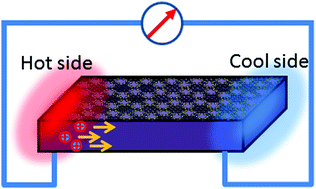Nanorods of a novel highly conductive 2D metal–organic framework based on perthiolated coronene for thermoelectric conversion†
Abstract
Conducting metal–organic frameworks (MOFs), especially those with high electrical conductivity (>10−3 S cm−1) have shown promising functions in many aspects. Here, nanorods of a novel metal–organic framework (MOF) based on perthiolated coronene (PTC) is synthesized by a homogeneous reaction. The structural, morphological and component analyses reveal that the nanorods are composed of a 2D Kagomé lattice with the formula of [Ni3(C24S12)]n. The compressed sample of the nanorods displays an electrical conductivity of ∼9 S cm−1 at 300 K and a weak semiconductor-like temperature dependence. Furthermore, a moderate Seebeck coefficient of 47.0 μV K−1 and an extremely low thermal conductivity of 0.2 W m−1 K−1 result in a figure of merit (ZT value) of thermoelectricity of 0.003 at 300 K. This is the best p-type thermoelectric performance in conducting MOFs ever reported.



 Please wait while we load your content...
Please wait while we load your content...